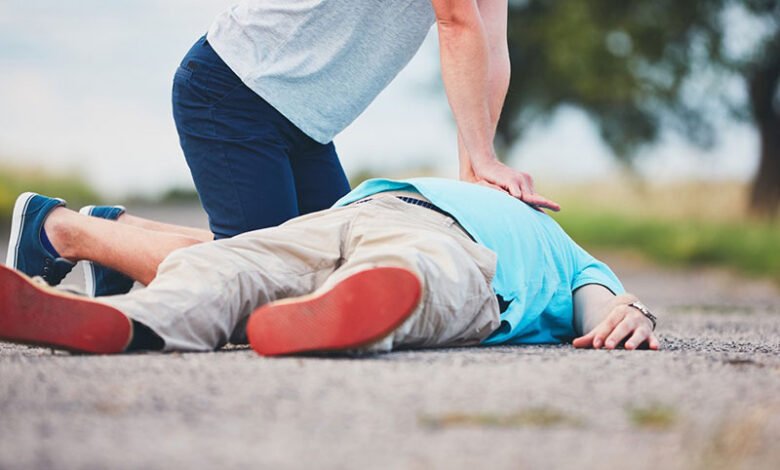What to Do When Someone Collapses: Responding to Cardiac Arrest?

Cardiac arrest can occur without warning, turning a normal moment into a life-or-death situation. The actions taken within the first few minutes are critical when someone collapses unexpectedly. Every second matters as the heart stops pumping blood to vital organs, especially the brain. Without immediate help, the chance of survival drops dramatically. Knowing how to respond quickly, confidently, and correctly is one of the most potent skills any individual can have. Whether in a workplace, public area, or at home, being prepared to act during a cardiac emergency is a responsibility that should not be overlooked.
Key actions that can help save a life
- Recognizing the Collapse and Staying Alert
When a person suddenly drops to the ground, unconscious and unresponsive, recognizing it as a potential cardiac arrest is the first step toward life-saving intervention. Many bystanders freeze in confusion, unsure if it’s a fainting spell, seizure, or something worse. It’s vital to assess quickly by checking for responsiveness. Speak to the person loudly, tap their shoulders, and observe for movement or signs of breathing. If there is no reaction and the person is not breathing or only gasping, cardiac arrest should be assumed. At this stage, hesitation can cost valuable time. Staying calm and calling emergency services is the next step, followed by preparing to begin chest compressions. Clarity and quick thinking turn what might feel like a chaotic moment into structured action. Recognizing the collapse isn’t just about observation—it’s about immediately switching to doing what’s necessary until help arrives.
See also: 5 Basement Remodeling Tips That Add Value for Transforming Unused Space
- Beginning Chest Compressions Without Delay
The moment a person is found unresponsive and not breathing normally, chest compressions should start immediately. Place the person on a flat surface and use the heel of one hand on the center of their chest, just between the nipples. Place the other hand on top, pressing hard and fast at 100 to 120 compressions per minute. The depth should be about two inches, allowing the chest to recoil fully between each push. This keeps oxygenated blood flowing to the brain and other organs until emergency responders take over. Studies show that uninterrupted compressions significantly increase survival rates, even without rescue breaths in the first few minutes. Those who have completed first aid CPR training often feel more confident in applying pressure correctly and maintaining rhythm without tiring too quickly. Physical effort is necessary, and switching with another person every few minutes, when possible, can keep compressions consistent and adequate.
- Using an Automated External Defibrillator (AED)
An Automated External Defibrillator—or AED—can be crucial in saving a life. These devices are commonly found in schools, offices, gyms, malls, and other public spaces. Once located, the AED should be turned on, and its voice instructions should be followed closely. The pads must be attached to the person’s bare chest as shown in the device diagrams, and the machine will assess the heart’s rhythm. If a shock is advised, bystanders should stand clear while it delivers the necessary jolt to try to reset the heart. Even if a shock is not needed, CPR should continue without pause. The AED does not replace compressions; it complements them by correcting abnormal heart rhythms if possible. Familiarity with AEDs through hands-on practice can reduce hesitation and confusion, making this life-saving tool seamless during high-stress scenarios. When used within the first few minutes, AEDs can drastically improve a person’s chance of survival.
- Involving Others and Managing the Scene
Cardiac arrest rarely happens in isolation, and multiple people are often nearby when someone collapses. One person should begin CPR while another calls for emergency help and finds an AED. Delegating tasks clearly and confidently avoids duplicated efforts or wasted time. Someone can guide emergency personnel to the location or comfort distressed bystanders, keeping the area clear and focused. Managing the scene also involves ensuring the safety of everyone present, especially in busy public areas where confusion can spread quickly. Loudly instructing those around to help or calling out for assistance can draw in support, and sometimes, trained individuals might be among the crowd. Team coordination is a force multiplier—when everyone knows their role and acts together, the response becomes faster, stronger, and more sustainable. Keeping composure during this process not only supports the person in crisis but can calm others and improve the overall effectiveness of the intervention.
- What Happens After Emergency Services Arrive
Once medical professionals reach the scene, they will take over the resuscitation process using advanced tools and medications. However, the information provided by bystanders, such as how long CPR was performed, whether an AED was used, or if the person had any recent symptoms, can help guide their next steps. Bystanders may feel relief as help arrives, but the experience can also leave emotional and physical exhaustion behind. It’s common to feel uncertain about whether the response was done “right,” but taking action is often the most critical factor. Paramedics, doctors, and nurses frequently emphasize that timely bystander intervention makes a measurable difference. For those involved, following up with a debrief, emotional support, or additional training can help process the experience and reinforce confidence. The impact doesn’t end when the ambulance leaves—the memory of what was done may stay with responders for life, often motivating continued readiness and learning.
Responding to a cardiac arrest begins with awareness and ends with action—the moments following someone’s collapse test readiness, determination, and composure. Recognizing the signs, calling for help, starting compressions, and using an AED are all parts of a chain that can restore life. These aren’t acts reserved for medical professionals; they’re actions anyone can take with a bit of knowledge and courage. Being prepared is not about waiting for emergencies—it’s about being able to face them when they arrive. Every second matters, and those who step forward, even in fear, make the difference between loss and hope.


